 W
WA ceremonial weapon is an object used for ceremonial purposes to display power or authority. They are often used in parades and as part of dress uniforms.
 W
WThe ceremonial baton is a short, thick stick-like object, typically in wood or metal, that is traditionally the sign of a field marshal or a similar high-ranking military officer, and carried as a piece of their uniform. The baton is distinguished from the swagger stick in being thicker and effectively without any practical function. A staff of office is rested on the ground; a baton is not. Unlike a royal sceptre that is crowned on one end with an eagle or globe, a baton is typically flat-ended.
 W
WThe bulava or buława is a ceremonial mace or baton.
 W
WThe ceremonial shield of the Tombs of Vergina is a decorative shield found in the Royal Tombs at Aigai in Northeast Greece. The shield was found alongside other lavish grave goods and the remains of family members of Alexander the Great, including Philip II of Macedon. The ceremonial shield dates to the late fourth century B.C.E. and was discovered in 1976.
 W
WThe City of London swords are five two-handed ceremonial swords owned by the City of London, namely the Mourning Sword, the Pearl Sword, the State Sword, the Old Bailey Sword and the Mansion House Justice Room Sword. A sixth sword, the Travelling Sword of State, replaces the Sword of State for visits outside the City. They are part of the plate collection of Mansion House, the official residence of the Lord Mayor of London.
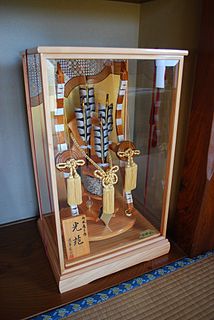 W
WThe hama yumi is a sacred bow used in 1103 A.D. in Japan. This bow is said to be one of the oldest and most sacred Japanese weapons; the first Emperor Jimmu is always depicted carrying a bow.
 W
WThe hetman's sign was the only native military symbol of the Polish–Lithuanian Commonwealth. It was invented by hetman Jan Tarnowski, who also popularized it on the territory of Poland in the second half of the sixteenth century. In Lithuania the hetman's sign was accepted in the following century. It became the most popular under reign of king Jan III Sobieski. Although he received the crown, he didn't reject his former attribute of authority. However, from the mid of the eighteenth century hetman's sign was replaced by horse-tail ensign.
 W
WKastane is a short traditional ceremonial/decorative single-edged Sri Lankan sword.
 W
WKotiate is a type of traditional hand weapon of the Māori, the indigenous people of New Zealand.
 W
WThe mace of the Senate of the Philippines is a ceremonial mace used as the symbol of authority in the Senate of the Philippines.
 W
WThe Mace of the United States House of Representatives also called the Mace of the Republic, is a ceremonial mace and one of the oldest symbols of the United States government. It symbolizes the governmental authority of the United States, and more specifically, the legislative authority of the House of Representatives.
 W
WIn the neopagan religion of Wicca, a range of magical tools are used in ritual practice. Each of these tools has different uses and associations, and not to serve primarily to direct magical energies. They are used at an altar, inside a magic circle.
 W
WA Mameluke sword is a cross-hilted, curved, scimitar-like sword historically derived from sabres used by Mamluk warriors of Mamluk Egypt after whom the sword is named. Egypt was, at least nominally, part of the Ottoman Empire and the sword most commonly used in Egypt was the same as used elsewhere in the empire, the kilij.
 W
WThe mere is a type of short, broad-bladed weapon in the shape of an enlarged tear drop. It was used to strike/jab an opponent in the body or the head, usually made from nephrite jade. A mere is one of the traditional, hand to hand, one-handed weapons of the indigenous Māori of New Zealand, and a symbol of chieftainship.
 W
WThe Model 1840 noncommissioned officers' sword was adopted by the United States military in 1840. Based primarily on a sword used by the French Army, the model 1840 NCO proved somewhat heavy hilted and ill balanced. For over 70 years, it was widely used by the Army; today its usage is restricted to ceremonial occasions. The sword had a 31-inch blade, a cast brass hilt resembling the more expensive wire-wrapped leather grips, and a leather scabbard rather than the steel used by cavalry troopers and officers, although some makers, such as Emerson and Silver, issued a steel scabbard rather than leather to protect from wear. Leather scabbards were phased out beginning in 1868.
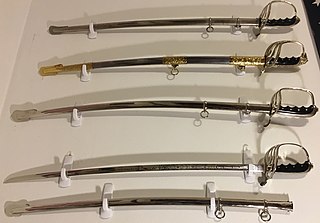 W
WThe Model 1902 Army Officers' Saber is the current sword used by officers of the United States Army. The official nomenclature for the current regulation U.S. Army saber is “saber for all officers, Model 1902”. It was adopted on July 17, 1902 by authority of General Order No. 81. The M1902 saber was authorized for all officers, both infantry and cavalry, with the exception of Chaplains. The lightly curved blade measures between 30 and 34 inches long with weights initially specified by the U.S. Army to be between 20.2 and 22.8 ounces and a point of balance of 3.25 inches from the hilt as specified for infantry sabers.
 W
WAn onavillu is a simple, short, bow-shaped musical instrument. Its name may come from Onam, a festival in Kerala where the instrument is used in dances, and villu, which means 'bow' in Malayalam. Although still regularly used in rural art forms, use of the onavillu is on the decline.
 W
WThe Queen's Truncheon is a ceremonial staff carried by the Royal Gurkha Rifles that serves as the equivalent of and is carried as the Colour. It is made of bronze and silver. The top represents the minaret of Delhi Palace with three Gurkhas standing on it supporting the Queen's crown above their heads. The minaret contains a pair of crossed kukris and carries the inscription "Main Picqet Hindoo Rao's House, Delhi 1857". The Truncheon is a unique emblem upon which recruits swear allegiance to the Regiment and the Crown.
 W
WA staff of office is a staff, the carrying of which often denotes an official's position, a social rank or a degree of social prestige.
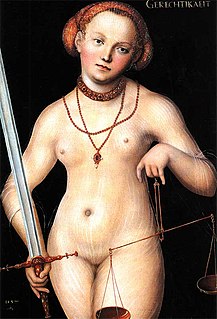 W
WA sword of justice is a ceremonial sword that is used to signify a monarch's supreme judicial power. In some cases, this may have been an executioner's sword that was no longer used for executions, becoming instead a ceremonial one.
 W
WA sword of state is a sword, used as part of the regalia, symbolizing the power of a monarch to use the might of the state against its enemies, and his or her duty to preserve thus right and peace.
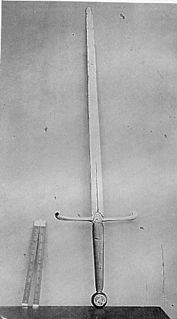 W
WThe Manx Sword of State is a ceremonial sword that represents the Tynwald on the Isle of Man. It represents the duties of the Sovereign of the Isle of Man, and is used every month in Tynwald, and annually during the Tynwald Day ceremony. There have been three swords used for such functions over the years. One is used for the ceremonies; one is housed in a museum; the other was lost in the 18th century. The Sword of State is popularly said to date to the mid 13th century, however it is not unlike 15th-century ceremonial swords used in England, and recent analysis dates it to the 15th century as well.
 W
WA taiaha is a traditional weapon of the Māori of New Zealand; a close-quarters staff weapon made from either wood or whalebone, and used for short, sharp strikes or stabbing thrusts with efficient footwork on the part of the wielder.
 W
WA tewhatewha is a long-handled Māori club weapon shaped like an axe. Designed to be held in two hands, the weapon comes to a mata (point) at one end and a rapa at the other.
 W
WThe Marine Corps noncommissioned officer's sword is a sword worn by noncommissioned officers (NCOs) and staff noncommissioned officers (SNCOs) of the United States Marine Corps. The NCO sword was adopted in 1859 and is patterned after the United States Army's foot officers' sword of 1850. The M1859 NCO sword continues service today as the Marine Corps drill and ceremonial sword. The sword's use is restricted by regulation to ceremonial occasions by an NCO or Staff NCO in charge of troops under arms or at weddings and wedding receptions where at least one of those being married is in uniform and has the rank of Corporal or higher.
 W
WUSMC Sword Manual Procedures are commonly used in the Marine Corps. Marines considered Non-commissioned Officers (NCO) as well as Staff Non-Commissioned Officers (SNCO) may find themselves having to perform "Sword Manual", which is a stationary drill.
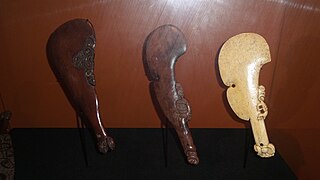 W
WA Wahaika is a type of traditional Māori hand weapon. Wahaika are short club-like weapons usually made of wood or whalebone and are used for thrusting and striking in close-quarter, hand-to-hand fighting. Whalebone wahaika are called wahaika parāoa.
 W
WA wand is a thin, light-weight rod that is held with one hand, and is traditionally made of wood, but may also be made of other materials, such as metal or plastic. Long versions of wands are often styled in forms of staves or sceptres, which could have large ornamentation on the top.
 W
WWeapons of Honour are ceremonial weapons awarded for service or assistance to France.
 W
WThe West Point Cadets' Sword is issued to cadet officers of the United States Military Academy at West Point, New York for wear when the uniform is designated as "under arms," to include formal functions, drill, parades, inspections and graduation. The swords are issued to cadets in their First Class (4th) year, and are returned to the Academy upon separation, although Cadets have the option of buying their saber or purchasing a newly made one. Despite its straight blade and lack of a knuckle guard, it is referred to by USMA staff and cadets as a "saber," likely because the commands for its manual of arms utilize that term as the command of execution